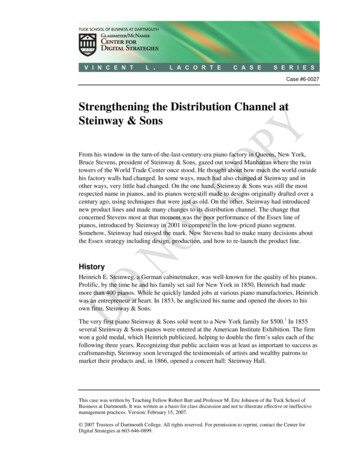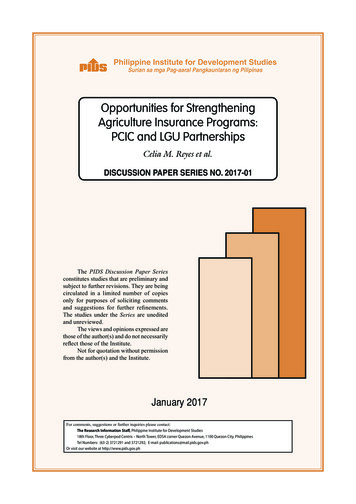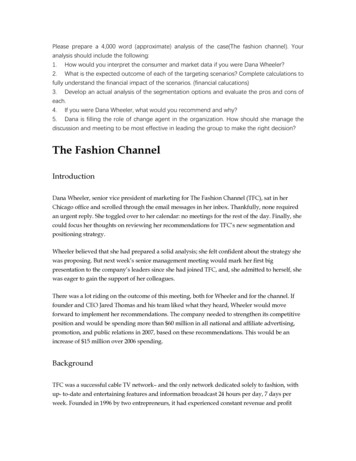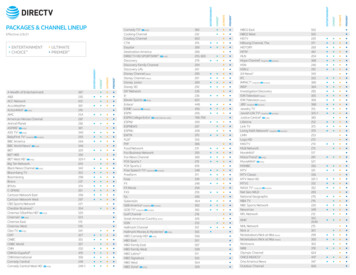
Transcription
Case #6-0027Strengthening the Distribution Channel atSteinway & SonsFrom his window in the turn-of-the-last-century-era piano factory in Queens, New York,Bruce Stevens, president of Steinway & Sons, gazed out toward Manhattan where the twintowers of the World Trade Center once stood. He thought about how much the world outsidehis factory walls had changed. In some ways, much had also changed at Steinway and inother ways, very little had changed. On the one hand, Steinway & Sons was still the mostrespected name in pianos, and its pianos were still made to designs originally drafted over acentury ago, using techniques that were just as old. On the other, Steinway had introducednew product lines and made many changes to its distribution channel. The change thatconcerned Stevens most at that moment was the poor performance of the Essex line ofpianos, introduced by Steinway in 2001 to compete in the low-priced piano segment.Somehow, Steinway had missed the mark. Now Stevens had to make many decisions aboutthe Essex strategy including design, production, and how to re-launch the product line.HistoryHeinrich E. Steinweg, a German cabinetmaker, was well-known for the quality of his pianos.Prolific, by the time he and his family set sail for New York in 1850, Heinrich had mademore than 400 pianos. While he quickly landed jobs at various piano manufactories, Heinrichwas an entrepreneur at heart. In 1853, he anglicized his name and opened the doors to hisown firm, Steinway & Sons.The very first piano Steinway & Sons sold went to a New York family for 500.1 In 1855several Steinway & Sons pianos were entered at the American Institute Exhibition. The firmwon a gold medal, which Heinrich publicized, helping to double the firm‘s sales each of thefollowing three years. Recognizing that public acclaim was at least as important to success ascraftsmanship, Steinway soon leveraged the testimonials of artists and wealthy patrons tomarket their products and, in 1866, opened a concert hall: Steinway Hall.This case was written by Teaching Fellow Robert Batt and Professor M. Eric Johnson of the Tuck School ofBusiness at Dartmouth. It was written as a basis for class discussion and not to illustrate effective or ineffectivemanagement practices. Version: February 15, 2007. 2007 Trustees of Dartmouth College. All rights reserved. For permission to reprint, contact the Center forDigital Strategies at 603-646-0899.
Strengthening the Distribution Channel at Steinway & SonsCase #6-0027After Heinrich‘s death in 1871, Steinway & Sons continued to grow under the direction of hisson William. In the 1870s, William opened a huge factory complex, including a residentialand commercial village for the employees in Queens, New York. The new facilities wereequipped to manufacture every part of a Steinway piano except its ivory keys.2 The companyalso extended its international influence, unveiling a London showroom in 1875 and a factoryin Hamburg, Germany in 1880.Toward the late 1800s, political unrest abroad and a troubled economy at home reduceddemand for pianos. The company teetered on the verge of bankruptcy and, after William diedin 1896, his nephews tried to sell it. Fortunately, they were unsuccessful, as the economyrebounded soon after and new trends, such as ragtime and silent pictures, had the publicclamoring for more and better pianos. By the end of the 1930s, Steinway outsourced ironplates and various other components, choosing instead to concentrate its efforts on its corecompetencies.By the early 1960s, Steinway was producing a wide variety of models, and orders for grandswere backlogged. But the rising costs of labor and materials, combined with Steinway‘sinventory-intensive production process, increasingly ate into the company‘s profits. Theentrance of lower-priced competitors into the market compounded these problems.For the second time in the company‘s history, the Steinway family considered selling out.This time, they did so. In 1972 they sold their company to CBS, which incorporated Steinway& Sons into its Musical Instruments Division. This division included Rhodes electric pianos,Fender guitars and amplifiers, Rogers drums, and Leslie speakers. Although, like Steinway,these instruments were renowned for their quality, some people wondered aloud whetherCBS would try to increase profits by compromising Steinway quality. CBS poured moneyinto its new venture, increasing annual capital spending at Steinway from 100,000 to 1–2million. Profits picked up, but rumors that Steinway quality had declined began to circulate.In 1985, when CBS sold off the Musical Instruments Division to a Boston group led bybrothers John P. and Robert Birmingham, Steinway & Sons was rolled into the newly createdSteinway Musical Properties. In 1995 Steinway Musical Properties was sold to Selmer Co.,the number one U.S. manufacturer of band instruments, including Selmer Paris saxophones,Bach trumpets and trombones, and Ludwig drums, and regrouped under the SteinwayMusical Instruments (SMI) umbrella. SMI common stock traded on the NYSE under theticker symbol LVB, honoring Ludwig von Beethoven. Chairman Kyle Kirkland and CEODana Messina held 100 percent of the class A stock with 86 percent of the voting rights.Steinway continued to grow with an eye on vertical integration and modernization. In late1998, SMI acquired Kluge, Europe‘s largest manufacturer of piano keys. Noted BruceStevens, ―We [were] very excited about this opportunity. Kluge has produced the industry‘sfinest piano keys since 1876 and for virtually that entire period Steinway & Sons has been amajor customer. Vertically integrating this acquisition will greatly improve ourmanufacturing efficiency.‖3Continuing in this vein, in 1999 SMI purchased O.S. Kelly, the largest U.S. manufacturer ofpiano plates. The piano plate provides a rigid frame needed to anchor the piano strings underTuck School of Business at Dartmouth—Glassmeyer/McNamee Center for Digital Strategies2
Strengthening the Distribution Channel at Steinway & SonsCase #6-0027tension. That same year, the New York City Industrial Development Agency (IDA) awardedSteinway approximately 4.2 million in ―land tax abatements, building tax stabilization, andsales tax exemptions on hard construction costs‖ to renovate and modernize Steinway‘snearly 100-year old, 421,000-square-foot factory. ―The ability to proceed with themodernization of our factory in Long Island City was vital to our long-term growth strategy,‖noted Steinway controller Dennis Tortora.4 The upgrade also ensured that the firm would stayin New York for a while longer.By 2005, net sales of Steinway pianos reached 203 million and demand for Steinway grandsexceeded domestic production (see Exhibit 1).Tradition of QualitySteinway had been a popular choice among artists throughout its history. Early on, the firmhad solicited the testimonials of renowned musicians, providing them with special pianos andpersonal tuners at concert appearances to cultivate their favor. By the early twenty-firstcentury, over 95 percent of piano soloists performing with major orchestras chose to performexclusively on Steinway pianos.5 Its roster of ―Steinway Artists‖ listed more than 900popular ensembles and concert pianists, including Van Cliburn, Harry Connick, Jr., and BillyJoel. In North America, artists selected their Steinway piano for concert performances fromthe company‘s unique ―piano bank,‖ an inventory of more than 300 pianos valued at over 15million.6 In exchange for their endorsement and valuable feedback on its pianos, SteinwayArtists were assured access to the best pianos anywhere in the world. Steinway wouldsometimes go to extraordinary lengths to ensure concert pianists had a piano that matchedtheir liking and style, including flying a piano to Buenos Aires for legendary pianist ArthurRubinstein when his usual instrument was waylaid in a dock-worker strike. The SteinwayArtist program is one of the true endorsement programs in the world as artists are not paidanything for their endorsement. (They are required, however, to own a Steinway.) Stevensnoted, ―The artists are our biggest fans and our toughest critics. Who knows better thanconcert pianists what quality means? We have to work very hard to satisfy them because theirlife depends on our piano. They love us, but if they found a better piano, they would switch.We know that and it motivates us every day.‖Quality handcraftsmanship and innovative techniques were part of the tradition HeinrichSteinway had established from the firm‘s inception. Nearly half the company‘s 120 patentedinventions were developed during its first 40 years in business, becoming the basis for the socalled ―Steinway system,‖ the eventual standard for piano manufacture.7 Particularly notableamong these were the technique of overstringing a grand piano to improve its bass sound andan improved cast-iron plate to support the tension of the strings.More than 150 years after its humble beginning, Steinway was producing about 3,000 pianosa year on its 11-acre site in Queens. However, the company‘s meticulous craftsmanship andattention to detail could not always keep pace with the demand for its grand pianos, despite aworkforce of about 450. Many of these employees were highly skilled craftsmen, often with15 or more years experience in the industry.Tuck School of Business at Dartmouth—Glassmeyer/McNamee Center for Digital Strategies3
Strengthening the Distribution Channel at Steinway & SonsCase #6-0027Each piano began as nothing more than raw lumber. The quality grades required by Steinwaywere unique. For wood suppliers, Steinway was their toughest customer—requiring a qualityfar beyond their other customers. Even if the wood made it to the factory, nearly 50 percentended up in the scrap bin.Production incorporated many of the labor-intensive techniques that had been created andpatented years earlier. For example, shaping the inner and outer piano rims by bending themas a single continuous piece, a process Steinway patented in 1878, was still used in 2006.These time-honored techniques, combined with top-of-the-line materials, were the chiefingredients of Steinway‘s production process.The process required eight to twelve months to turn a pile of lumber into a 100,000 concertgrand piano. The vast majority of the work was hand-done by skilled craftsmen. The rim wasbent by hand, or more correctly, by the brute force of six men. The plate was fitted to the rimby hand. The keys and hammers were adjusted by hand. The strings were tuned by hand. Andthe case was polished by hand.However, Steinway was not resistant to change itself, just to change that could adverselyaffect the quality of the product. A few operations were assisted by machines. An automaticwinder was used to wind the strings around the tuning pins and drive them into the pin block.The soundboard was trimmed to the exact size of the plate by a CNC router. Also, a machinewas used to play scales endlessly (and without complaint) to break in the piano.Every Steinway was made the same way, by the same people, with the same process. Yetevery Steinway still ended up being a little different from every other Steinway. They mightlook alike, but each one had a unique sound signature. The signature was in the nuances ofthe tone, the coloration of the notes, and the strength of the voice. Some instruments weremellow and meek, while others might be so powerful that they could overpower a fullsymphony orchestra. Each piano also had its own feel or touch. The sound and touch gaveeach Steinway its own personality.The CompetitionSteinway competed in the high-end grand market with long-time European brands such asBosendorfer and Bechstein, and newcomer Fazioli. While the U.S. once had many pianomakers, by 2000 most had either failed or been acquired by foreign firms. In the midmarkets, Steinway‘s competitors included Mason & Hamlin, an old New England firmrescued from bankruptcy in the mid-1990s by newcomer PianoDisc; Korean powerhouseSamick, established in 1958 and owner of many old brands such as Kohler & Campbell;Asian competitors and partners like Kawai and Young Chang; and longtime rivals Baldwinand Yamaha (see Exhibit 2).Domestic. Baldwin, the largest American piano builder, was the brainchild of DwightHamilton Baldwin, a reed organ and violin teacher who dreamed of creating ―the best pianothat could be built.‖ In 1891 he unveiled an upright model and four years later introduced thefirst Baldwin grand piano, a 5‘4‖ model. By 1913 Baldwin was exporting pianos to 32Tuck School of Business at Dartmouth—Glassmeyer/McNamee Center for Digital Strategies4
Strengthening the Distribution Channel at Steinway & SonsCase #6-0027countries around the world. As at Steinway, the Depression and World War II took its toll onpiano sales, but by 1953, Baldwin had doubled its pre-war production.Baldwin introduced its flagship model, the nine-foot SD10 Concert Grand, which thecompany touted as ―a major advancement in piano design‖ in 1965. The company furtherenhanced its lines in 1988 with the purchase of The Wurlitzer Company‘s keyboard divisionand seven years later with the reintroduction of the Chickering name—a nineteenth centuryrival of Steinway—on a line of its grand pianos.In the 1990s, Baldwin faltered, eventually declaring bankruptcy in 2001. The company wasacquired by prestigious guitar and musical instrument manufacturer Gibson GuitarCorporation. Baldwin offered several lines of grand pianos as well as uprights, digitals, andpiano software in a wide range of pricing. These products were sold under several brandnames including Baldwin, Wurlitzer, Chickering, Hamilton, and Howard.Foreign. Yamaha was founded in Japan by Torakusu Yamaha in 1887 to produce reedorgans. The first upright piano was crafted in 1900 and a new grand model in 1902. Yamahafirst created its own concert grand piano in the 1960s. These grands, like Steinway‘s, werecrafted by hand
06.10.2016 · plates and various other components, choosing instead to concentrate its efforts on its core competencies. By the early 1960s, Steinway was producing a wide variety of models, and orders for grands were backlogged. But the rising costs of labor and materials, combined with Steinway‘s inventory-intensive production process, increasingly ate into the company‘s profits. The entrance of lower .











